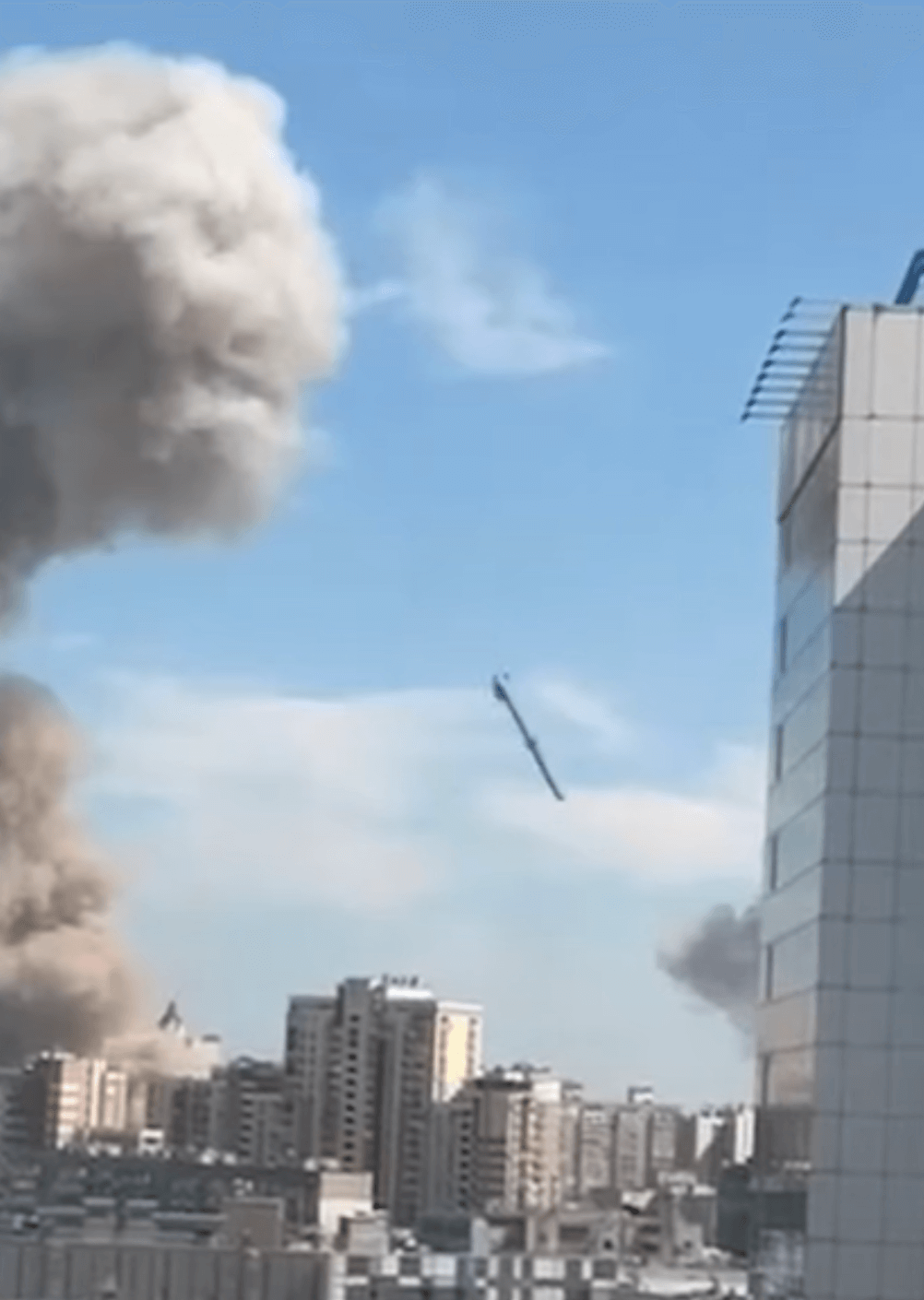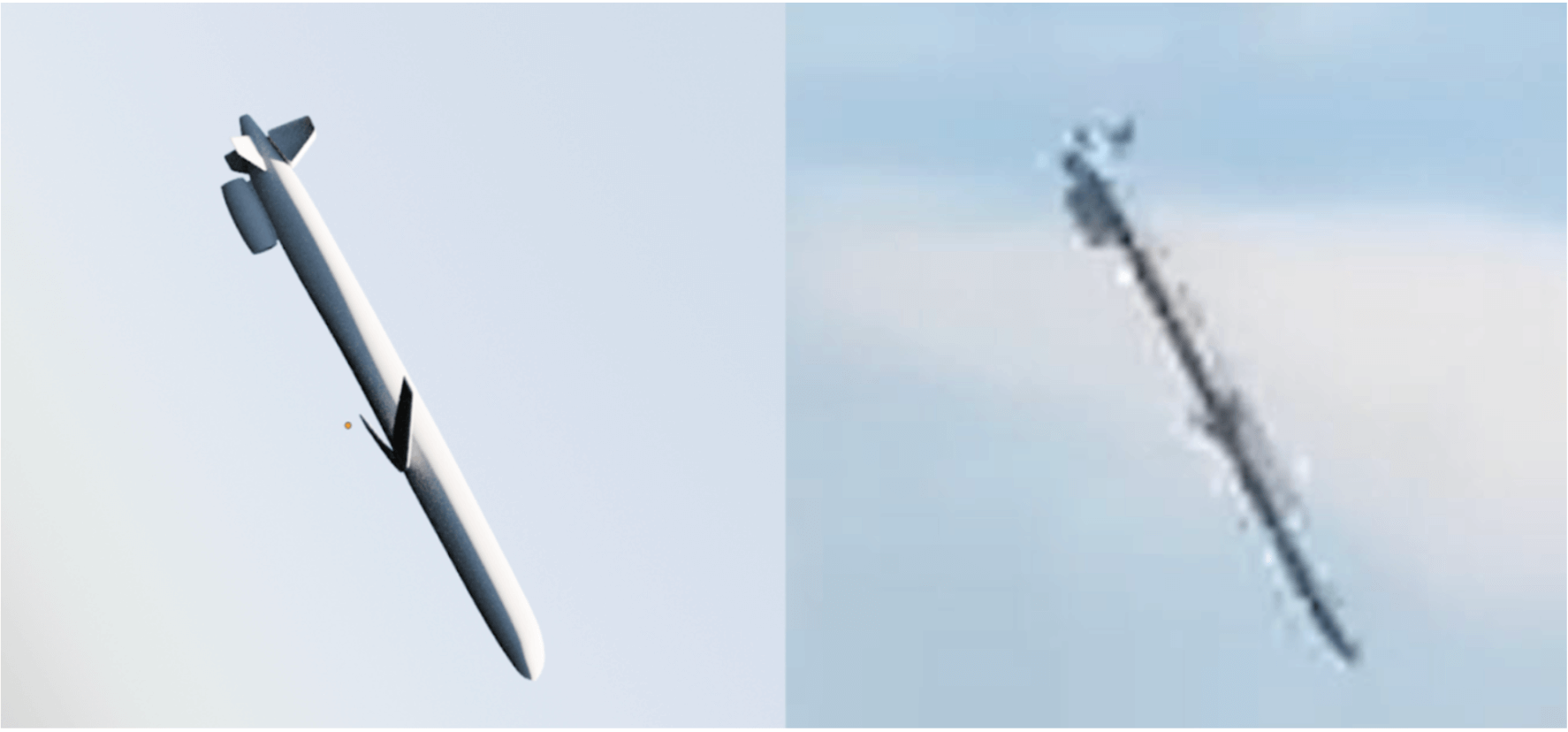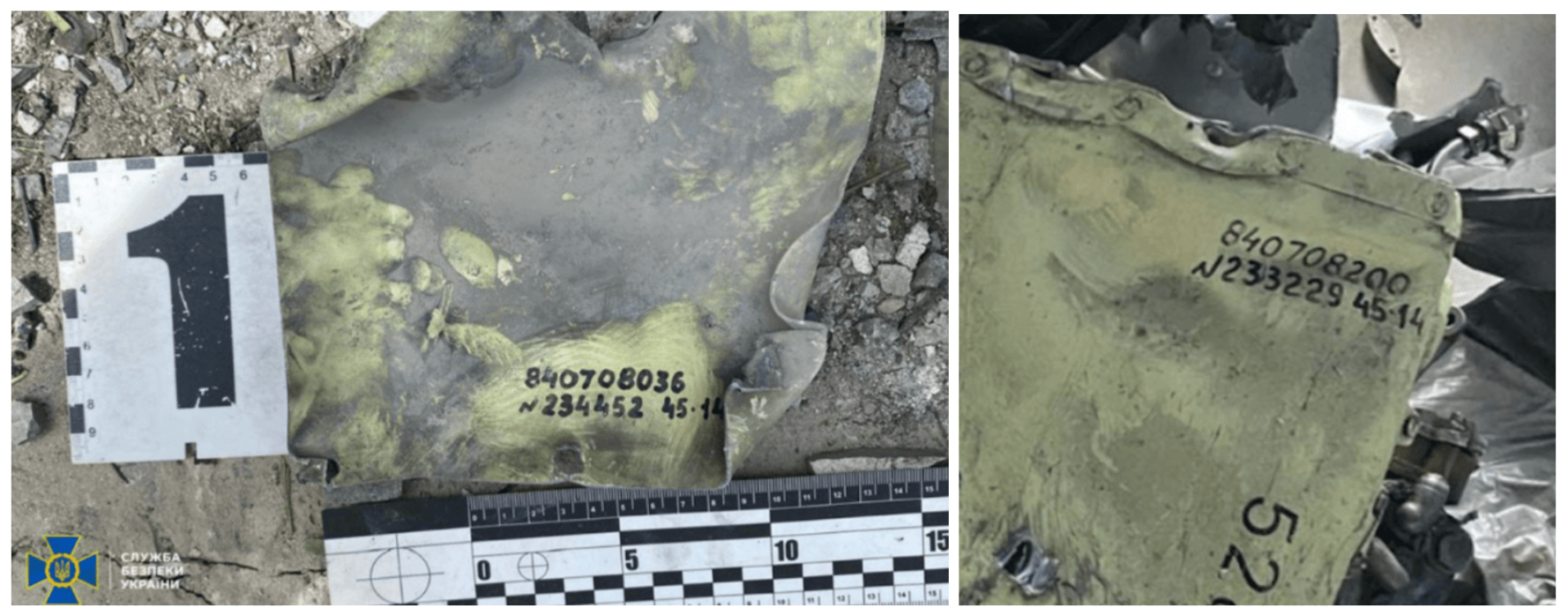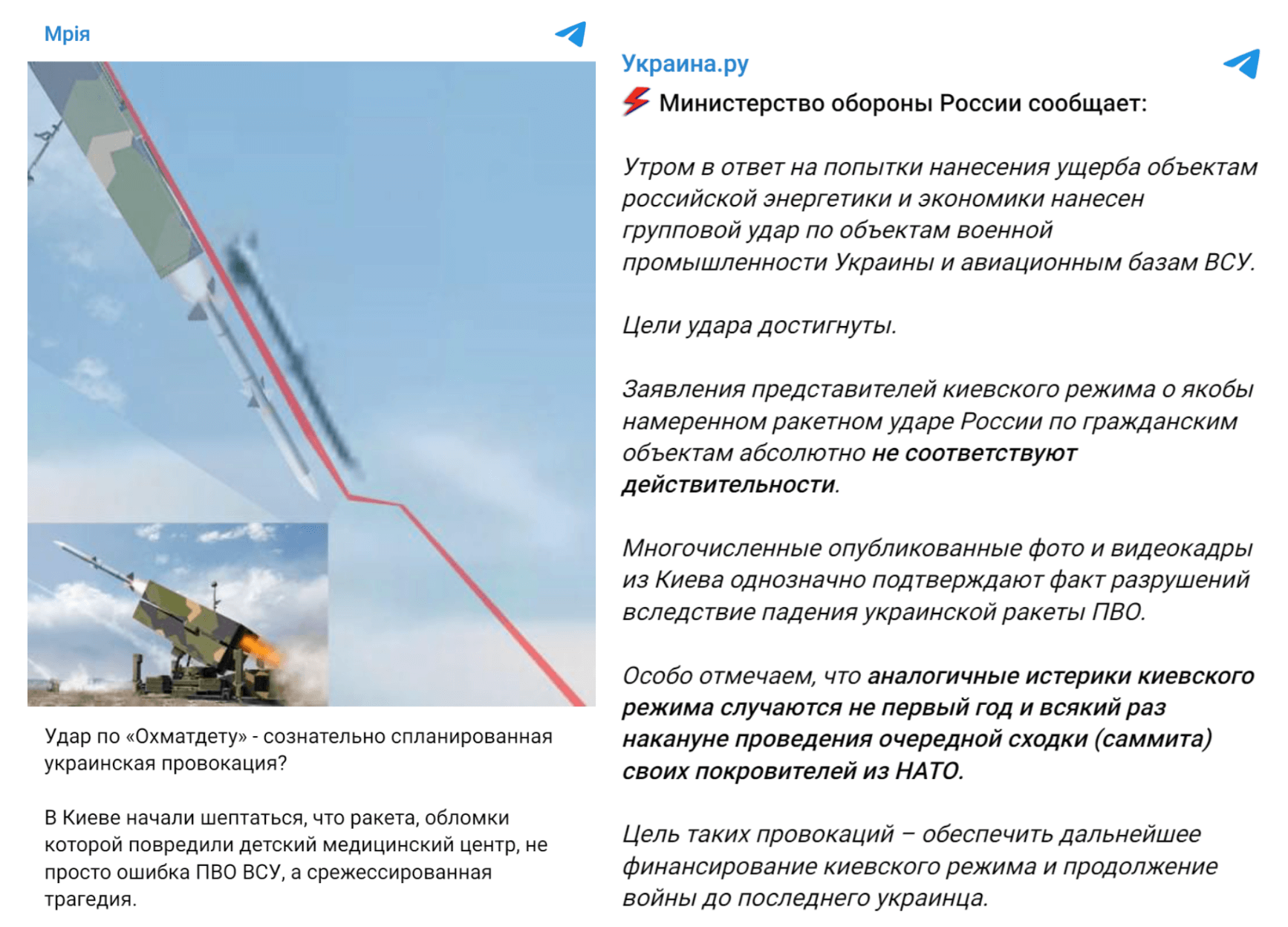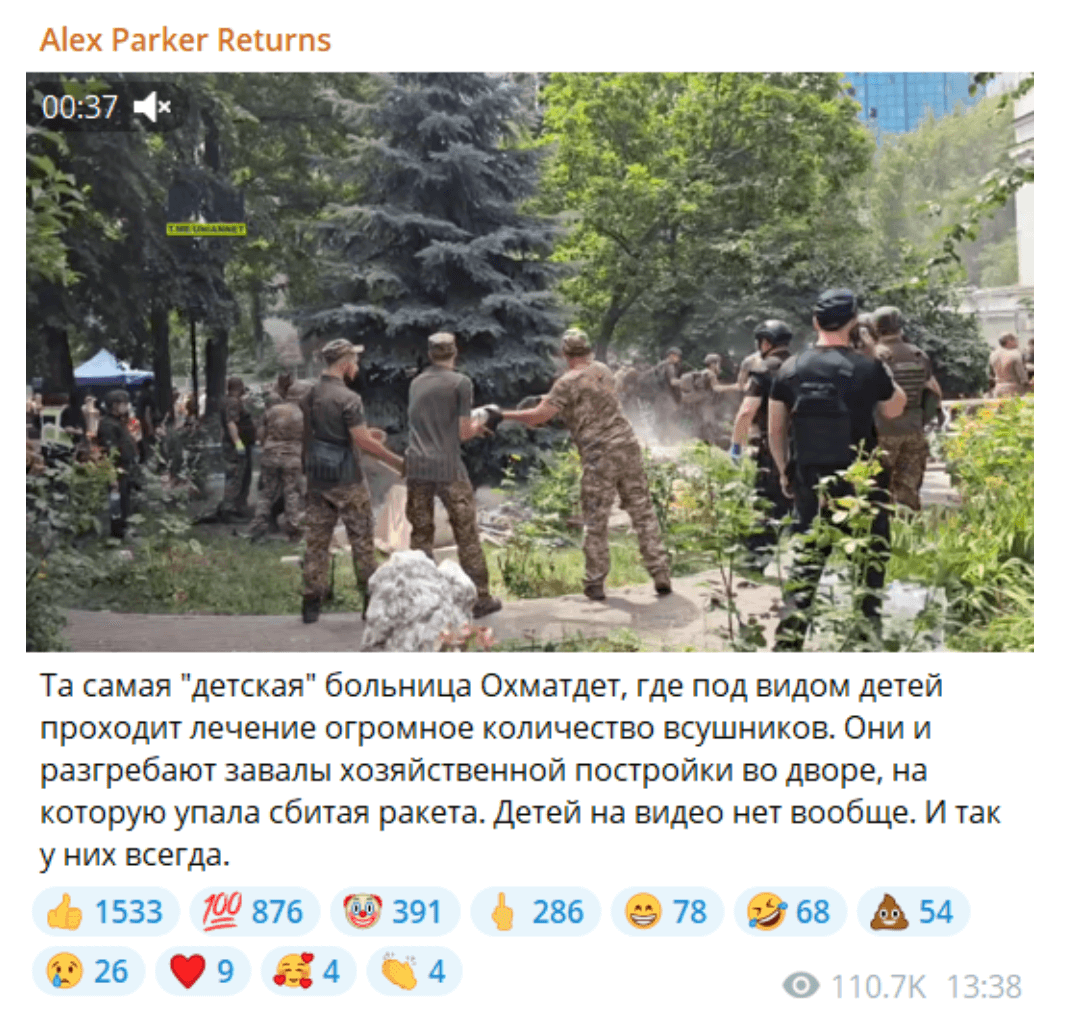The morning of July 8 began with a new wave of terror for Ukraine from the Russian Federation. While enemy channels were filled with greetings for Russia’s Family Day and proclamations of family values as the foundation of Russian society, the Russian army cynically struck Ukrainian civilians, once again demonstrating their hypocrisy.
While Russians were celebrating, Ukrainians were hiding from bombings and losing loved ones. This, however, will never be shown on Russian television or Telegram channels. Instead, as per their established method, they will say, “It wasn’t us” and “We weren’t there”, repeating their evergreen narratives. So, let’s analyze the versions that Kremlin mouthpieces used to justify yet another war crime.
“We were targeting military objectives”
As per the propagandist manual, after every crime, the Kremlin shifts responsibility onto the victim, in this case, Ukraine. Almost immediately after the strike on civilian objects in Ukraine, the Russians reported “achieving their objectives”. They all uniformly stated that they “delivered a group strike with high-precision long-range weapons on Ukrainian military industrial facilities and air force bases“. The Russians accused Ukraine of “lying” about the strike being planned and targeting civilian infrastructure.
In reality, this is another lie, as numerous pieces of evidence from both Ukraine and international media prove that Russia deliberately struck civilian objects and peaceful residents. Furthermore, under international humanitarian law, even during an attack on genuine military objects, methods that minimize civilian casualties must be chosen. The use of weapons that are not high-precision and pose a threat to civilians is prohibited.
Kremlin Telegram channels regularly justify strikes on “Ukrainian Armed Forces warehouses” but provide no evidence that they were actually located at the site. To lend more legitimacy to their words, Telegram channels fabricated a story that an “important people meeting” was taking place in a building near the Okhmatdyt hospital.
Russia has used this justification tactic at least since the First Chechen War in 1994-1996. For example, in 1995, the then-head of the Russian Air Force claimed that his army was hitting “only military objects” and not civilian buildings in Grozny. “Only military targets” was a thesis repeated by the Russians after bombarding civilian objects in Georgia in 2008, and in Ukrainian cities following the aggression in 2014.
“It wasn’t a Russian missile that hit Okhmatdyt, but a Ukrainian air defense missile”
Blaming Ukrainian air defense is another part of the propagandist manual. Along with photos of the destroyed Okhmatdyt, propagandists spread the narrative that “Ukrainian militants are deliberately shelling Ukraine’s civilian population to blame the Russians“, and that the hospital was “hit by an AIM-120 air defense missile from the NASAMS system used by Ukraine”.
The missile strike is clearly visible in the videos circulated by the Russians themselves. According to the Security Service of Ukraine, the Okhmatdyt was hit by a Russian Kh-101 strategic cruise missile. Debris from the tail section of the Kh-101, including a serial number and part of its rudder, was found at the site.
OSINT analysts from Molfar noted that the missile had a typical downward trajectory and showed no visible damage, debunking the version that “the missile deviated from its course due to Ukrainian air defense“.
A screenshot from the video of the missile strike on the Okhmatdyt hospital on July 8, 2024. Source: “TSN”
The Kh-101 missile strike was also confirmed by independent international investigators from Bellingcat and Fabian Hoffmann, a missile technology specialist from the University of Oslo. Bellingcat experts checked the Russian version involving the AIM-120 missile but found no evidence supporting it.
On the left is a 3D model of the Kh-101 missile; on the right is the missile that hit Okhmatdyt. Source: Bellingcat
Bellingcat compared the missile debris published by the Security Service of Ukraine with parts of the Kh-101 missile previously shot down over Ukraine. The experts found similar serial numbers: “840708036”, “№234452” and “45 • 14” on the missile debris near Okhmatdyt and “840708200”, “№233229” and “45 • 14” on the part of a Kh-101 shot down over Ukraine on December 29, 2023. Ministry of Justice employees identified over 30 different missile fragments near Okhmatdyt. Part of the numbers — is a fragment of the engine’s outer casing with a production number.
On the left are fragments of the Kh-101 missile that hit the Okhmatdyt hospital; on the right is a fragment of a Kh-101 missile shot down over Ukraine on December 29, 2023. Source: Bellingcat
“Defense Forces deliberately did not shoot down Russian missiles”
Another Russian lie that does not withstand any criticism. On July 8, the Russian army of terror launched a combined missile strike on Ukraine using air, sea, and land-based missiles.
A representative of the Air Force of the Armed Forces of Ukraine, Yurii Ihnat, explained that during the July 8 bombardment, cruise missiles were flying at very low altitudes. This complicates the detection and destruction of Russian missiles and increases potential damage if they are shot down. Additionally, the missiles are equipped with extra countermeasures, such as radar and thermal decoys.
Despite this, the military does everything possible to protect the civilian population from enemy missiles. Specifically, on the morning of July 8, the Air Force of the Armed Forces of Ukraine shot down 30 out of 38 Russian missiles. Such attacks on civilians once again demonstrate to the international community the need to strengthen military aid to Ukraine: to increase the supply of air defense systems and ammunition, expedite the delivery of F-16s, and expand the range within which Ukraine can strike Russian military targets with Western weapons.
“Strikes on Ukraine are a staged provocation before the NATO Summit”
Several hours after the shelling, Russian channels continued to blatantly lie and invent new justifications for their war crime. For example, some Telegram channels resorted to accusing Ukraine of “staging“. They claimed that the shelling of Okhmatdyt was a “staged Ukrainian provocation” to “warm up” the NATO summit informationally, get more money from partners, and “raise the level of hatred among the masses”.
Screenshots of Russian publications
Additionally, propagandists called Ukraine’s statements about the shelling “media cries”, claiming that no child was supposedly harmed. According to the latest data, the July 8 shelling in Kyiv killed 33 people, including 5 children, and injured 121 people, including 10 wounded children. In Kryvyi Rih, 10 civilians were killed and 47 were injured. In Dnipro, one person was killed and 12 were injured.
Accusations of “staging” by Ukraine are not new. Russians actively promoted this narrative after the war crimes in Bucha when the whole world saw the true “face” of Russia. At that time, Kremlin channels published absurd posts about “staging”, with “evidence” reduced to loud claims of “it’s all Ukrainians” without any real proof.
Along with this, Russians accused the Ukrainian government of spreading “thematic guidelines” to ensure the media only covered the situation with the Okhmatdyt hospital. They alleged that the government was trying to “divert attention” from other Russian strikes on Kyiv, where military objects are directly located. However, Ukrainian media published reports not only from the Okhmatdyt clinic but also about hits on a house in Syrets, a building in Lukianivka, a medical clinic in the Dniprovskyi district, and strikes in Kryvyi Rih and Dnipro.
“Military personnel, not children, were hiding and receiving treatment in the hospital”
Continuing to justify the crime, propagandists claimed that instead of children, military personnel of the Defense Forces were being treated in the Okhmatdyt hospital. As “evidence”, they cite a video showing military personnel and workers from various services helping to clear the aftermath of the enemy attack in the building opposite the hospital.
In reality, there were no reports of injured or killed military personnel as a result of the strike in Kyiv. Instead, there are numerous photos and videos online showing injured civilians, including medical staff and children, who were in the building at the time of the strike — 627 children were inside at that moment. As a result of the attack on Okhmatdyt, eight children were injured. One boy died on July 10; at the time of the strike, he was in intensive care and was later transferred to another Kyiv hospital.
Some Telegram channels acknowledged that there were children in the hospital but immediately accused Okhmatdyt of allegedly not even attempting to move the children to a bomb shelter. The air raid siren in Kyiv sounded at 9:52 AM, and the first reports of explosions appeared at 10:27 AM. Immediately after the siren, the hospital ceased operations and began evacuating patients to the shelter. The director of Okhmatdyt, Volodymyr Zhovnir, explained that this is a rather complicated process, especially for children in intensive care. At the time of the attack, three complex surgeries were being performed. According to Valerii Bovkun, the head of one of the departments, the surgery had started before the air raid siren and could not be interrupted. The child was not injured because the surgeons conducting the operation shielded the child with their bodies.
Why does Russia spread such statements?
First and foremost, Russians attempt to shift responsibility for their crimes to the victim — Ukraine — and divert attention from the real facts. Additionally, all Russian tactics used to justify the July 8 shelling are identical to those employed in previous shellings.
Moreover, the propagandists lack any logic, as they add “new versions” to each statement that actually contradict each other. This reveals another goal — not just to justify the crime but also to confuse the audience, blur reality, and ensure that in the flood of information, the truth gets lost while the fabrications remain.
Notably, the voice of propaganda is not only in Russian. In social media, several Kremlin supporters in the West, such as Jackson Hinkle, promoted the Russian fake about the “Ukrainian air defense missile hitting the hospital”. Thus, these falsehoods are spread not only among Russians and Ukrainians but globally.
The July 8 attack is also part of a strategy to intimidate and demoralize, particularly to show Ukrainians what awaits them if they refuse to negotiate on Russia’s terms. Through such missile attacks, Russia tries to impose its own rules on the world and force Ukraine to negotiate sooner. This Russian pressure has even influenced some Ukrainian bloggers, who have started calling for negotiations in their social media, even if it means giving up their own territories. However, Russia is not truly interested in “peace”. As the occupiers themselves say — on July 10, Medvedev openly stated that they would seize all of Ukraine as soon as Moscow and Kyiv sign a “peace treaty” and end the war.
An unpunished crime repeats
On July 8, 2024, Polish Prime Minister Donald Tusk and Volodymyr Zelenskyi met in Warsaw. The joint conference began with a moment of silence. Tusk condemned the Russian strike and noted that Ukraine needs the help of “the entire civilized world”, and stated that Poland is ready to help the affected children. The Russian strike was also condemned by the UK, the USA, Czechia, Estonia, Moldova, Latvia, and other countries. Meanwhile, China, which supports Russia and helps it circumvent sanctions, called for “cooling down the situation and creating conditions for the earliest possible cessation of hostilities and political resolution of the crisis”.
However, global support was frankly insufficient, as the statements of world leaders were mostly limited to “concern” without practical steps, such as announcing new sanctions or providing weapons. There was, however, a notable reaction from Czechia, which, after a UN meeting, summoned the Russian ambassador and handed him a note of protest. During the NATO summit on July 10, 2024, the President of the United States announced that the USA, Germany, the Netherlands, Romania, and Italy would provide Ukraine with five additional air defense systems. The President of Ukraine expressed gratitude and noted that these systems would help, but it is still not enough, considering the latest Russian attack.
Thus, the Russian terror attack serves as a reminder to Western partners that Russia will not abandon its ambitions, despite numerous Ukrainian casualties and destruction. Peace in Europe is impossible without Ukraine’s victory. Achieving it is possible through continued military support, strengthened sanctions, and holding Russia fully accountable for every war crime against Ukraine.
The West must also continue to fight disinformation: blocking Russian-affiliated media, not giving platforms to pro-Russian speakers, and increasing moderation of fake content on social media. The world must hear, see, and know the truth: Russia is a terrorist state. If crime and lies go unpunished, they are doomed to be repeated again and again.
Attention
The authors do not work for, consult to, own shares in or receive funding from any company or organization that would benefit from this article, and have no relevant affiliations
